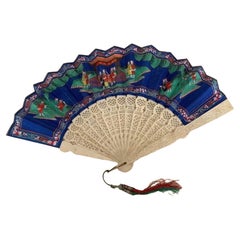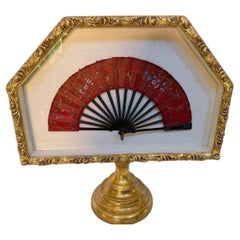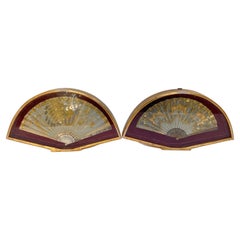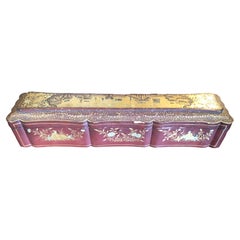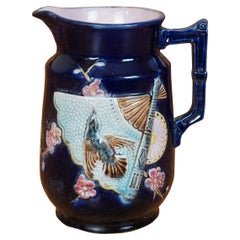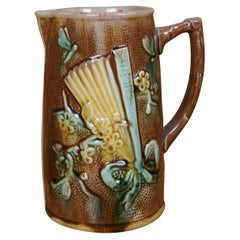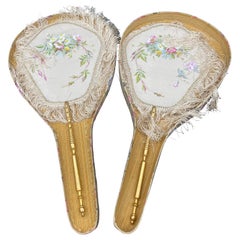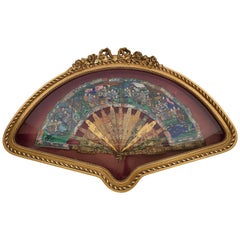Antique Chinese Fan
19th Century Chinese Chinese Export Antique Chinese Fan
Bone, Silk
Late 19th Century Chinese Qing Antique Chinese Fan
Lacquer
1850s Chinese Qing Antique Chinese Fan
Silk
Early 19th Century Chinese Antique Chinese Fan
Silk, Wood, Paint
Late 19th Century Victorian Antique Chinese Fan
Majolica
Late 19th Century Victorian Antique Chinese Fan
Majolica
Late 19th Century Chinese Qing Antique Chinese Fan
Silk
1850s Chinese Qing Antique Chinese Fan
Lacquer
1850s Chinese Qing Antique Chinese Fan
Lacquer
1850s Chinese Qing Antique Chinese Fan
Lacquer
19th Century English Chinoiserie Antique Chinese Fan
Porcelain
19th Century Chinese Chinese Export Antique Chinese Fan
Glass, Wood
19th Century Chinese Qing Antique Chinese Fan
Wood
Early 19th Century Chinese Qing Antique Chinese Fan
Lacquer
19th Century Chinese Qing Antique Chinese Fan
Lacquer
1830s Chinese Qing Antique Chinese Fan
Lacquer
Late 19th Century Chinese Qing Antique Chinese Fan
Lacquer
Early 20th Century Chinese Chinoiserie Antique Chinese Fan
Bamboo
Early 20th Century Chinese Qing Antique Chinese Fan
Glass
Mid-19th Century Chinese Antique Chinese Fan
Bone, Paper
1830s Chinese Qing Antique Chinese Fan
Lacquer
1830s Chinese Qing Antique Chinese Fan
Lacquer
Mid-19th Century Chinese Antique Chinese Fan
Enamel
Early 19th Century Chinese Qing Antique Chinese Fan
Silver, Enamel
Late 17th Century Chinese Qing Antique Chinese Fan
Silver, Enamel
Early 20th Century Chinese Chinoiserie Antique Chinese Fan
Silk, Wood
19th Century Asian Antique Chinese Fan
Bronze
Early 20th Century Modern Antique Chinese Fan
Ink, Tempera
19th Century Chinese Baroque Antique Chinese Fan
19th Century Chinese Antique Chinese Fan
Lacquer, Paper
Early 1900s French Antique Chinese Fan
Terracotta
Late 19th Century Chinese Qing Antique Chinese Fan
Early 20th Century Chinese Chinese Export Antique Chinese Fan
Silver
19th Century Chinese Antique Chinese Fan
Glass, Wood, Mirror
Late 19th Century Brazilian Chinoiserie Antique Chinese Fan
Porcelain
19th Century Chinese Qing Antique Chinese Fan
Paper
19th Century Chinese Qing Antique Chinese Fan
Paper
Late 19th Century Chinese Antique Chinese Fan
19th Century Chinese Antique Chinese Fan
Wood
19th Century Chinese Antique Chinese Fan
Bronze
1920s Chinese Antique Chinese Fan
Hardwood
Early 1900s Japanese Meiji Antique Chinese Fan
Wood
19th Century Chinese Antique Chinese Fan
Wood
Mid-19th Century Chinese Rustic Antique Chinese Fan
Elm
Late 19th Century Chinese Qing Antique Chinese Fan
Elm
Mid-19th Century Chinese Qing Antique Chinese Fan
Wood
Mid-19th Century Chinese Qing Antique Chinese Fan
Birch
19th Century Antique Chinese Fan
19th Century Chinese Antique Chinese Fan
Porcelain
Mid-19th Century Chinese Antique Chinese Fan
19th Century Chinese Antique Chinese Fan
Bronze
Early 20th Century Chinese Qing Antique Chinese Fan
Ceramic
19th Century Chinese Chinoiserie Antique Chinese Fan
Paper
Mid-19th Century Chinese Chinese Export Antique Chinese Fan
Sandalwood, Lacquer
18th Century Chinese Qing Antique Chinese Fan
Jade
Early 20th Century Chinese Chinese Export Antique Chinese Fan
Tortoise Shell, Fabric, Silk
Early 17th Century Chinese Ming Antique Chinese Fan
Porcelain
18th Century Chinese Chinese Export Antique Chinese Fan
Silver
Late 19th Century Chinese Antique Chinese Fan
Soapstone
Mid-19th Century Chinese Qing Antique Chinese Fan
Brass
- 1
Antique Chinese Fan For Sale on 1stDibs
How Much is a Antique Chinese Fan?
- 1stDibs ExpertApril 5, 2022A Chinese hand fan is sometimes called a rigid or fixed fan. It refers to a folding fan that became popular during the Ming Dynasty and was often crafted with fine materials, such as ivory, bone or pearl, with paper or fabric coverings decorated with intricate designs. You’ll find a selection of Chinese hand fans on 1stDibs.
- 1stDibs ExpertApril 5, 2022To identify an antique fan, search all over for a maker's mark. Then, consult an authoritative online reference to match the mark to the manufacturer's name. A licensed appraiser can also assist with identification. You'll find a collection of expertly vetted antique fans on 1stDibs.
- 1stDibs ExpertNovember 4, 2024To identify antique Chinese furniture, look carefully at its details. Chinese craftsmen often built furniture using mortise and tenon joinery, eliminating the need for nails and screws. If you see this type of hardware, your piece is likely not at least 100 years old, especially if the hardware still looks new and shiny. Since antique furniture was handmade, you will normally see slight imperfections, such as tool marks or slight variations in carvings. Pieces that appear completely uniform and pristine are less often genuine antiques.
When present, maker's marks can also be helpful. Research the marks to learn more about when the maker was active and producing pieces like yours. Alternatively, you can have a certified appraiser or experienced antique dealer evaluate your furniture for you.
Shop an assortment of antique Chinese furniture.  PAGODA REDOctober 7, 2020
PAGODA REDOctober 7, 2020To determine the age of a Chinese furniture piece, look carefully at the joinery and finish. Natural expansion and contraction of the wood over time will cause a joint to protrude or retract, distorting a once-seamless fit. Antique lacquer finishes become crackled and worn over time. Areas of exposed wood, such as the underside of a table, the footrest of a chair, or the back of a cabinet should appear raw and dry compared to the finished surface. With use, the legs of tables and chairs become weathered near the bottom from precipitation and use.
 Lotus GallerySeptember 23, 2020
Lotus GallerySeptember 23, 2020The best way to know is to take it to an expert, such as an appraiser, reputable dealer or auction house, or museum
